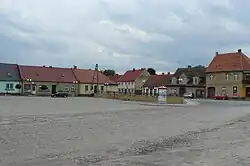Nowe Miasto nad Wartą
Nowe Miasto nad Wartą (Polish: [ˈnɔvɛ ˈmjastɔ nad ˈvartɔ̃]) is a village in Środa Wielkopolska County, Greater Poland Voivodeship, in west-central Poland. It is the seat of the gmina (administrative district) called Gmina Nowe Miasto nad Wartą.[1] It lies approximately 19 kilometres (12 mi) south-east of Środa Wielkopolska and 49 km (30 mi) south-east of the regional capital Poznań.
Nowe Miasto nad Wartą | |
|---|---|
Village | |
 Market Square | |
 Nowe Miasto nad Wartą | |
| Coordinates: 52°5′N 17°24′E | |
| Country | |
| Voivodeship | Greater Poland |
| County | Środa Wielkopolska |
| Gmina | Nowe Miasto nad Wartą |
| Population | 1,543 |
History
The development of New Town on the Warta River was connected to its location at a river crossing on the road from Poznań to Kalisz. New Town was founded in the 13th century by Mikołaj of Dębno, a member of the Doliwa coat of arms, whose descendants eventually made it their permanent residence. New Town on the Warta was first mentioned as a city in a decree issued by Przemysł II on October 2, 1283, in which he subjected New Town (referred to as "Civitas nova") to the jurisdiction of Kalisz and forbade the townspeople of New Town to appeal to courts other than those in Kalisz. The town was granted city rights in the year 1300.
In the Middle Ages, New Town was the seat of the important Doliwa family in Greater Poland, who in the 13th and 14th centuries owned a fortified residential tower called a "motte" on the Kopiec hill, which was a type of knightly residence. In 1383, the wooden structures of the tower and its outbuildings were destroyed during a civil war between the Grzymalita and Nałęcz families. The wooden tower on Kopiec was rebuilt, and by the end of the Middle Ages, a masonry manor was constructed in its place, which was still visible as ruins in the 19th century. The remnants of this residence have survived as a cone-shaped hill known as Kopiec. A wooden church must have existed in 1393 because a parish priest's presence was confirmed in that year. In 1485, Adam Nowomiejski sold one-third of the town to his uncle Jan Rozdrażewski of the Doliwa coat of arms, along with some villages, for 1300 grzywien, and the following year, Jan Rozdrażewski sold it to his son, also named Jan Rozdrażewski. In 1507, Hieronim Rozdrażewski received one-third of the town in a division among the brothers. In 1529, the Rozdrażewski family became the sole owners of the town due to some ruthless actions. Hieronim's grandson, Jan Rozdrażewski Nowomiejski, the bishop of Włocławek, died in New Town in 1609. In the 15th century, a defensive knightly manor was built to the west of the church on the site of the current kindergarten building, and remnants of its masonry cellars still remain.
In the 16th century, the town was administratively located in the Kalisz Voivodeship. In 1664, another town named Laskówka was established nearby, and in the 18th century, it was absorbed by New Town as one of its suburbs. Until the Second Partition of Poland in 1793, New Town was part of the Kalisz Voivodeship. After the partition, it became part of the Kingdom of Prussia and its province of South Prussia. In 1848, the town served as the base for the Greater Poland Uprising during the Spring of Nations. Between 1880 and 1895, the Prussian government built a bridge over the Warta, a granary, a warehouse, and other buildings related to the port in Orzechowo on the Piaski. The economic prosperity of the riverside complex was disrupted by World War I, which broke out in 1914. In 1934, New Town lost its city rights.